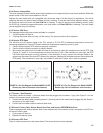
62
MODEL FCL-1056 SECTION 9.0
TROUBLESHOOTING
9.3.10 Sensor RTD Out of Range
Both the chlorine and pH sensor contain a Pt 100 RTD (resistance temperature device) for measuring temperature.
If the measured resistance is outside the expected range, the analyzer will display the out of range error message.
1. Check wiring connections.
2. Disconnect the sensor from the cable and use an ohmmeter to check the resistance across the RTD. See
Figures 9-1 and 9-2. The resistance should be about 110 Ω. If there is an open or short circuit, the sensor
has failed and should be replaced. If the resistance is acceptable, attach the sensor to the Variopol cable and
disconnect the RTD IN and RTD RTN leads at the analyzer. Connect an ohmmeter across the leads and
measure the resistance. If the circuit is open or shorted, the cable must be replaced.
3. If there is no open or short, check the analyzer. See Section 9.10.2.
9.3.11 Glass Z Too High
The sensing element in the pH sensor is a thin glass membrane. Normally, the impedance of the glass membrane
is about 80-100 MΩ. As the glass membrane ages, the impedance increases. A large increase in glass impedance
suggests that the sensor is near the end of its useful life.
9.3.12 Reference Impedance Too High
The Model 3900VP pH sensor supplied with the FCL-02 has a porous reference junction, so the normal reference
impedance is low, less than 5 kΩ. High reference impedance suggests that the junction is severely fouled, the fill
solution has become depleted, or the junction is not fully submerged in the sample.
1. Confirm that sample is flowing to the pH flow cell.
2. Clean the reference junction.
3. Check the sensor in buffers. If readings are accurate and the response is reasonably rapid (<5 minutes to
reach a stable reading), the sensor is usable. Clear the fault by increasing the reference impedance fault limit.
See Section 5.8.2.
4. Replace the sensor if the response in buffers is bad.
9.3.13 Broken Glass
The sensing element in the pH sensor is a thin glass membrane. Normally, the impedance of the glass membrane
is about 80-100 MΩ. If the glass membrane gets broken or cracked, the impedance will drop to less than 10 MΩ.
1. Check sensor settings under the Measurement submenu. Confirm that the pre-amplifier location is set to “analyzer”.
2. Confirm that the pH sensor is installed in the flow cell and sample is flowing through the cell.
3. Check the sensor response in two buffers having different pH values. If the membrane is cracked or broken,
the pH reading will be about the same in both buffers.
4. Replace the pH sensor.


















